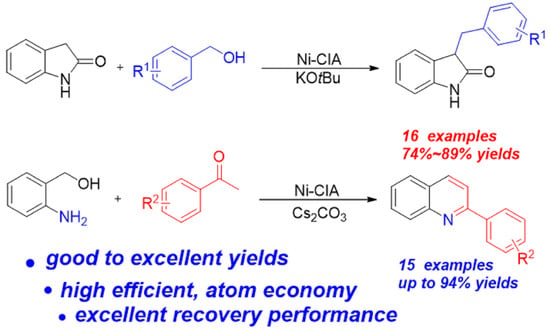Recyclable Ni-Containing Coordination Polymer as an Efficient Catalyst for the Synthesis of Oxindole and Quinoline Derivatives through the Borrowing Hydrogen Strategy
Abstract
:1. Introduction
2. Results and Discussion
2.1. Characterization of Ni-CIA
2.2. Catalytic Activity
2.3. Mechanism Explorations
2.4. Reusability of the Catalyst
3. Materials and Methods
3.1. Catalyst Characterization
3.2. Chemicals
3.3. Catalyst Preparation
3.4. Alkylation of 2-Oxindole with Alcohols
3.5. Reaction of Synthesis of Quinoline Derivatives
4. Conclusions
Supplementary Materials
Author Contributions
Funding
Acknowledgments
Conflicts of Interest
References
- Jiang, T.; Kuhen, K.L.; Wolff, K.; Yin, H.; Bieza, K.; Caldwell, J.; Bursulaya, B.; Wu, T.Y.; He, Y. Design, synthesis and biological evaluations of novel oxindoles as HIV-1 non-nucleoside reverse transcriptase inhibitors. Part I. Bioorg. Med. Chem. Lett. 2006, 16, 2105–2108. [Google Scholar] [CrossRef] [PubMed]
- Wang, H.; Chen, M.; Wang, L. Selective Synthesis and Utility of One Tripyrrolic Compound and Its Intermediates. Chem. Pharm. Bull. 2007, 55, 1439–1441. [Google Scholar] [CrossRef] [Green Version]
- Reisman, S.E.; Ready, J.M.; Weiss, M.M.; Hasuoka, A.; Hirata, M.; Tamaki, K.; Ovaska, T.V.; Smith, C.J.; Wood, J.L. Evolution of a Synthetic Strategy: Total Synthesis of (±)-Welwitindolinone A Isonitrile. J. Am. Chem. Soc. 2008, 130, 2087–2100. [Google Scholar] [CrossRef] [PubMed] [Green Version]
- Rodrigues, T.; Reker, D.; Schneider, P.; Schneider, G. Counting on natural products for drug design. Nat. Chem. 2016, 8, 531–541. [Google Scholar] [CrossRef]
- Huang, L.; Yang, L.; Wan, J.P.; Zhou, L.; Liu, Y.; Hao, G. Metal-free three-component assemblies of anilines, alpha-keto acids and alkyl lactates for quinoline synthesis and their anti-inflammatory activity. Org. Biomol. Chem. 2022, 20, 4385–4390. [Google Scholar] [CrossRef] [PubMed]
- Liu, H.; Zeng, X.-Q.; Zuo, H.-W.; Zhang, N.; Huang, Z.-Y. Design, Synthesis and Seed Germination Inhibition Activity of Quinoline-6-sulfonamide Compounds. Chin. J. Org. Chem. 2022, 42, 2947–2953. [Google Scholar] [CrossRef]
- Moutaouakil, M.; Tighadouini, S.; Almarhoon, Z.M.; Al-Zaben, M.I.; Bacha, A.B.; Masand, V.H.; Jamaleddine, J.; Saddik, R. Quinoline Derivatives with Different Functional Groups: Evaluation of Their Catecholase Activity. Catalysts 2022, 12, 1468. [Google Scholar] [CrossRef]
- Hu, C.; Lu, L.; Wan, J.P.; Wen, C. The Pharmacological Mechanisms and Therapeutic Activities of Hydroxychloroquine in Rheumatic and Related Diseases. Curr. Med. Chem. 2017, 24, 2241–2249. [Google Scholar] [CrossRef]
- Trost, B.M.; Zhang, Y. Molybdenum-Catalyzed Asymmetric Allylation of 3-Alkyloxindoles: Application to the Formal Total Synthesis of (−)-Physostigmine. J. Am. Chem. Soc. 2006, 128, 4590–4591. [Google Scholar] [CrossRef]
- Kende, A.S.; Hodges, J.C. Regioselective C-3 Alkylations of Oxindole Dianion. Synth. Commun. 2007, 12, 1–10. [Google Scholar] [CrossRef]
- Chaudhari, M.B.; Sutar, Y.; Malpathak, S.; Hazra, A.; Gnanaprakasam, B. Transition-Metal-Free C-H Hydroxylation of Carbonyl Compounds. Org. Lett. 2017, 19, 3628–3631. [Google Scholar] [CrossRef] [PubMed]
- Chakraborty, S.; Daw, P.; David, Y.B.; Milstein, D. Manganese-Catalyzed alpha-Alkylation of Ketones, Esters, and Amides Using Alcohols. ACS Catal. 2018, 8, 10300–10305. [Google Scholar] [CrossRef]
- Duan, Y.T.; Wang, Z.X. Transition-Metal-Free α-C-Alkylation of Oxindoles with Alcohols. Asian J. Org. Chem. 2023, 12, e202300015. [Google Scholar] [CrossRef]
- Luo, X.; Tian, A.; Pei, M.; Yan, J.; Liu, X.; Wang, L. Highly Stable Univalent Copper of a Cu@Al/SBA-15 Nanocomposite Catalyzes the Synthesis of Fluorescent Aminobenzotriazoles Derivatives. Chem. Eur. J. 2022, 28, e202103361. [Google Scholar] [CrossRef] [PubMed]
- Wang, D.; Xia, X.; Hu, W.; Yang, Y.; Li, J. Catalytic Synthesis of Pyrazine and Ketone Derivatives by Unsymmetrical Triazolyl-Naphthyridinyl-Pyridine Copper. Chin. J. Org. Chem. 2022, 42, 190–199. [Google Scholar] [CrossRef]
- Pena-Lopez, M.; Piehl, P.; Elangovan, S.; Neumann, H.; Beller, M. Manganese-Catalyzed Hydrogen-Autotransfer C-C Bond Formation: Alpha-Alkylation of Ketones with Primary Alcohols. Angew. Chem. Int. Ed. Engl. 2016, 55, 14967–14971. [Google Scholar] [CrossRef]
- Li, J.; Mao, A.; Yao, W.; Zhu, H.; Wang, D. Iridium supported on porous polypyridine-oxadiazole as high-activity and recyclable catalyst for the borrowing hydrogen reaction. Green Chem. 2022, 24, 2602–2612. [Google Scholar] [CrossRef]
- Wang, D.; Ge, B.; Zhang, B.; Liu, H.; Li, J. Synthesis of Supported Indazolyl-Pyridyl-Quinoline Iridium Catalyst and Its Application to N-Alkylation of 2-Aminobenzothiazoles. Chin. J. Org. Chem. 2022, 42, 619–630. [Google Scholar] [CrossRef]
- Banik, A.; Datta, P.; Mandal, S.K. C-Alkylation by Phenalenyl-Based Molecule via a Borrowing Hydrogen Pathway. Org. Lett. 2023, 25, 1305–1309. [Google Scholar] [CrossRef]
- Chen, X.; Liu, D.; Yang, C.; Shi, L.; Li, F. Hexaazatrinaphthalene-Based Covalent Triazine Framework-Supported Rhodium(III) Complex: A Recyclable Heterogeneous Catalyst for the Reductive Amination of Ketones to Primary Amines. Inorg. Chem. 2023, 62, 9360–9368. [Google Scholar] [CrossRef]
- Liu, Y.; Diao, H.; Hong, G.; Edward, J.; Zhang, T.; Yang, G.; Yang, B.M.; Zhao, Y. Iridium-Catalyzed Enantioconvergent Borrowing Hydrogen Annulation of Racemic 1,4-Diols with Amines. J. Am. Chem. Soc. 2023, 145, 5007–5016. [Google Scholar] [CrossRef]
- Ng, T.W.; Tao, R.; See, W.W.L.; Poh, S.B.; Zhao, Y. Economical Access to Diverse Enantiopure Tetrahydropyridines and Piperidines Enabled by Catalytic Borrowing Hydrogen. Angew. Chem. Int. Ed. 2023, 62, e202212528. [Google Scholar] [CrossRef] [PubMed]
- Hamid, M.H.S.A.; Slatford, P.A.; Williams, J.M.J. Borrowing Hydrogen in the Activation of Alcohols. Adv. Synth. Catal. 2007, 349, 1555–1575. [Google Scholar] [CrossRef]
- Nakayama, T.; Harada, S.; Kikkawa, S.; Hikawa, H.; Azumaya, I. Palladium-Catalyzed Dehydrogenative Synthesis of Imidazoquinolines in Water. Asian J. Org. Chem. 2022, 11, e202200510. [Google Scholar] [CrossRef]
- Putra, A.E.; Takigawa, K.; Tanaka, H.; Ito, Y.; Oe, Y.; Ohta, T. Transition-Metal-Catalyzed Regioselective Alkylation of Indoles with Alcohols. Eur. J. Org. Chem. 2013, 2013, 6344–6354. [Google Scholar] [CrossRef]
- Yang, Q.; Wang, Q.; Yu, Z. Substitution of alcohols by N-nucleophiles via transition metal-catalyzed dehydrogenation. Chem. Soc. Rev. 2015, 44, 2305–2329. [Google Scholar] [CrossRef]
- Huang, F.; Liu, Z.; Yu, Z. C-Alkylation of Ketones and Related Compounds by Alcohols: Transition-Metal-Catalyzed Dehydrogenation. Angew. Chem. Int. Ed. 2016, 55, 862–875. [Google Scholar] [CrossRef]
- Corma, A.; Navas, J.; Sabater, M.J. Advances in One-Pot Synthesis through Borrowing Hydrogen Catalysis. Chem. Rev. 2018, 118, 1410–1459. [Google Scholar] [CrossRef]
- Alig, L.; Fritz, M.; Schneider, S. First-Row Transition Metal (De)Hydrogenation Catalysis Based on Functional Pincer Ligands. Chem. Rev. 2019, 119, 2681–2751. [Google Scholar] [CrossRef]
- Irrgang, T.; Kempe, R. 3d-Metal Catalyzed N- and C-Alkylation Reactions via Borrowing Hydrogen or Hydrogen Autotransfer. Chem. Rev. 2019, 119, 2524–2549. [Google Scholar] [CrossRef]
- Reed-Berendt, B.G.; Latham, D.E.; Dambatta, M.B.; Morrill, L.C. Borrowing Hydrogen for Organic Synthesis. ACS Cent. Sci. 2021, 7, 570–585. [Google Scholar] [CrossRef]
- Volk, B.; Mezei, T.; Simig, G. Raney Nickel-Induced 3-Alkylation of Oxindole with Alcohols and Diols. Synthesis 2002, 2002, 595–597. [Google Scholar] [CrossRef]
- Grigg, R.; Whitney, S.; Sridharan, V.; Keep, A.; Derrick, A. Iridium catalysed C-3 alkylation of oxindole with alcohols under solvent free thermal or microwave conditions. Tetrahedron 2009, 65, 4375–4383. [Google Scholar] [CrossRef]
- Jensen, T.; Madsen, R. Ruthenium-Catalyzed Alkylation of Oxindole with Alcohols. J. Org. Chem. 2009, 74, 3990–3992. [Google Scholar] [CrossRef]
- Bisht, G.S.; Chaudhari, M.B.; Gupte, V.S.; Gnanaprakasam, B. Ru-NHC Catalyzed Domino Reaction of Carbonyl Compounds and Alcohols: A Short Synthesis of Donaxaridine. ACS Omega 2017, 2, 8234–8252. [Google Scholar] [CrossRef] [Green Version]
- Dambatta, M.B.; Polidano, K.; Northey, A.D.; Williams, J.M.J.; Morrill, L.C. Iron-Catalyzed Borrowing Hydrogen C-Alkylation of Oxindoles with Alcohols. ChemSusChem 2019, 12, 2345–2349. [Google Scholar] [CrossRef] [Green Version]
- Saini, P.; Dolui, P.; Nair, A.; Verma, A.; Elias, A.J. A Bench-stable 8-Aminoquinoline Derived Phosphine-free Manganese (I)-Catalyst for Environmentally Benign C(alpha)-Alkylation of Oxindoles with Secondary and Primary Alcohols. Chem. Asian J. 2023, 18, e202201148. [Google Scholar] [CrossRef]
- Wu, Q.; Pan, L.; Du, G.; Zhang, C.; Wang, D. Preparation of pyridyltriazole ruthenium complexes as effective catalysts for the selective alkylation and one-pot C–H hydroxylation of 2-oxindole with alcohols and mechanism exploration. Org. Chem. Front. 2018, 5, 2668–2675. [Google Scholar] [CrossRef]
- Liu, G.; Huang, T.; Zhang, Y.; Liang, X.; Li, Y.; Li, H. C-3 alkylation of oxindole with alcohols catalyzed by an indene-functionalized mesoporous iridium catalyst. Catal. Commun. 2011, 12, 655–659. [Google Scholar] [CrossRef]
- Chaudhari, C.; Siddiki, S.M.A.H.; Kon, K.; Tomita, A.; Tai, Y.; Shimizu, K. C-3 alkylation of oxindole with alcohols by Pt/CeO2 catalyst in additive-free conditions. Catal. Sci. Technol. 2014, 4, 1064–1069. [Google Scholar] [CrossRef]
- Putra, A.E.; Oe, Y.; Ohta, T. Pd/C-Catalyzed Alkylation of Heterocyclic Nucleophiles with Alcohols through the “Borrowing Hydrogen” Process. Eur. J. Org. Chem. 2015, 2015, 7799–7805. [Google Scholar] [CrossRef]
- Fujita, S.; Imagawa, K.; Yamaguchi, S.; Yamasaki, J.; Yamazoe, S.; Mizugaki, T.; Mitsudome, T. A nickel phosphide nanoalloy catalyst for the C-3 alkylation of oxindoles with alcohols. Sci. Rep. 2021, 11, 10673. [Google Scholar] [CrossRef] [PubMed]
- Li, J.; Yu, M.; Duan, Z.-C.; Zhu, H.; Yao, W.; Wang, D. Porous cross-linked polymer copper and iridium catalyzed the synthesis of quinoxalines and functionalized ketones under solvent-free conditions. Mater. Chem. Front. 2021, 5, 7861–7872. [Google Scholar] [CrossRef]
- Zhao, S.; Wang, Y.; Dong, J.; He, C.-T.; Yin, H.; An, P.; Zhao, K.; Zhang, X.; Gao, C.; Zhang, L.; et al. Ultrathin metal–organic framework nanosheets for electrocatalytic oxygen evolution. Nat. Energy 2016, 1, 16184. [Google Scholar] [CrossRef]
- Stoica, A.-C.; Damoc, M.; Zaltariov, M.-F.; Racles, C.; Cazacu, M. Two-dimensional coordination polymers containing permethylated motifs-promising candidates for 2D emerging materials. Structural, behavioral and functional particularities. React. Funct. Polym. 2021, 168, 105039. [Google Scholar] [CrossRef]
- Farid, S.; Mao, Q.; Ren, S.; Hao, C.; Dong, X. Promoting the Oxygen Evolution Reaction via Morphological Manipulation of a Lamellar Nanorod-Assembled Ni(II)-Pyrazolate Superstructure. ACS Appl. Mater. Interfaces 2022, 14, 47775–47787. [Google Scholar] [CrossRef]
- Duan, J.; Jin, W.; Kitagawa, S. Water-resistant porous coordination polymers for gas separation. Coord. Chem. Rev. 2017, 332, 48–74. [Google Scholar] [CrossRef] [Green Version]
- Griffin, S.E.; Domecus, G.P.; Flores, C.E.; Sikma, R.E.; Benz, L.; Cohen, S.M. A Coordination Polymer of Vaska’s Complex as a Heterogeneous Catalyst for the Reductive Formation of Enamines from Amides. Angew. Chem. Int. Ed. 2023, 62, e202301611. [Google Scholar] [CrossRef]
- Gui, S.; Tang, W.; Huang, Z.; Wang, X.; Gui, S.; Gao, X.; Xiao, D.; Tao, L.; Jiang, Z.; Wang, X. Ultrasmall Coordination Polymer Nanodots Fe-Quer Nanozymes for Preventing and Delaying the Development and Progression of Diabetic Retinopathy. Adv. Electron. Mater. 2023, 300261. [Google Scholar] [CrossRef]
- Hu, X.; Zhu, H.; Sang, X.; Wang, D. Design and Synthesis of Zirconium-Containing Coordination Polymer Based on Unsymmetric Indolyl Dicarboxylic Acid and Catalytic Application on Borrowing Hydrogen Reaction. Adv. Synth. Catal. 2018, 360, 4293–4300. [Google Scholar] [CrossRef]
- Sang, X.; Hu, X.; Tao, R.; Zhang, Y.; Zhu, H.; Wang, D. A Zirconium Indazole Carboxylate Coordination Polymer as an Efficient Catalyst for Dehydrogenation-Cyclization and Oxidative Coupling Reactions. ChemPlusChem 2020, 85, 123–129. [Google Scholar] [CrossRef] [Green Version]
- Tao, R.; Yang, Y.; Zhu, H.; Hu, X.; Wang, D. Ligand-tuned cobalt-containing coordination polymers and applications in water. Green Chem. 2020, 22, 8452–8461. [Google Scholar] [CrossRef]
- Chang, S.; Liu, H.; Shi, G.; Xia, X.-F.; Wang, D.; Duan, Z.-C. Copper–cobalt coordination polymers and catalytic applications on borrowing hydrogen reactions. New J. Chem. 2022, 46, 15929–15936. [Google Scholar] [CrossRef]
- Han, M.-R.; Kong, X.-J.; Feng, S.-S.; Lu, L.-P. Synthesis, Structure and Magnetic Studies of a Ni(II) Coordination Polymer Constructed from Asymmetrical Tetracarboxylic Acid and N-Donor Ligand. J. Clust. Sci. 2021, 33, 809–814. [Google Scholar] [CrossRef]
- Xu, J.; He, S.; Zhang, H.; Huang, J.; Lin, H.; Wang, X.; Long, J. Layered metal–organic framework/graphene nanoarchitectures for organic photosynthesis under visible light. J. Mater. Chem. A 2015, 3, 24261–24271. [Google Scholar] [CrossRef]
- Osadchii, D.Y.; Olivos-Suarez, A.I.; Bavykina, A.V.; Gascon, J. Revisiting Nitrogen Species in Covalent Triazine Frameworks. Langmuir 2017, 33, 14278–14285. [Google Scholar] [CrossRef] [Green Version]
- Jia, X.; Zhang, B.; Chen, C.; Fu, X.; Huang, Q. Immobilization of chitosan grafted carboxylic Zr-MOF to porous starch for sulfanilamide adsorption. Carbohydr. Polym. 2021, 253, 117305. [Google Scholar] [CrossRef]
- Wu, H.; Li, S.; Liu, Y.; Liu, M.; Shi, Y. Metal–Organic Framework-Derived Hollow Carbon Nanosphere@Ni/Reduced Graphene Oxide Composites for Supercapacitor Electrodes with Enhanced Performance. ACS Appl. Nano Mater. 2023, 6, 1582–1591. [Google Scholar] [CrossRef]
- Shang, X.F.; Morris-Natschke, S.L.; Yang, G.Z.; Liu, Y.Q.; Guo, X.; Xu, X.S.; Goto, M.; Li, J.C.; Zhang, J.Y.; Lee, K.H. Biologically active quinoline and quinazoline alkaloids part II. Med. Res. Rev. 2018, 38, 1614–1660. [Google Scholar] [CrossRef]
- Juvale, K.; Gallus, J.; Wiese, M. Investigation of quinazolines as inhibitors of breast cancer resistance protein (ABCG2). Bioorg. Med. Chem. 2013, 21, 7858–7873. [Google Scholar] [CrossRef]
- Michael, J.P. Quinoline, quinazoline and acridone alkaloids. Nat. Prod. Rep. 2002, 19, 742–760. [Google Scholar] [CrossRef] [PubMed]
- Chen, Z.; Song, J.; Peng, X.; Xi, S.; Liu, J.; Zhou, W.; Li, R.; Ge, R.; Liu, C.; Xu, H.; et al. Iron Single Atom Catalyzed Quinoline Synthesis. Adv. Mater. 2021, 33, e2101382. [Google Scholar] [CrossRef] [PubMed]
- Xu, X.; Ai, Y.; Wang, R.; Liu, L.; Yang, J.; Li, F. Ruthenium-catalyzed acceptorless dehydrogenative coupling of o-aminobenzyl alcohols with ketones to quinolines in the presence of carbonate salt. J. Catal. 2021, 395, 340–349. [Google Scholar] [CrossRef]
- Yu, K.; Chen, Q.; Liu, W. Iron-catalysed quinoline synthesis via acceptorless dehydrogenative coupling. Org. Chem. Front. 2022, 9, 6573–6578. [Google Scholar] [CrossRef]
- Hao, Z.; Zhou, X.; Ma, Z.; Zhang, C.; Han, Z.; Lin, J.; Lu, G.L. Dehydrogenative Synthesis of Quinolines and Quinazolines via Ligand-Free Cobalt-Catalyzed Cyclization of 2-Aminoaryl Alcohols with Ketones or Nitriles. J. Org. Chem. 2022, 87, 12596–12607. [Google Scholar] [CrossRef]
- Chen, X.; Ai, Y.; Liu, D.; Liu, P.; Xu, X.; Yang, J.; Li, F. A recyclable covalent triazine framework-supported iridium(iii) terpyridine complex for the acceptorless dehydrogenative coupling of o-aminobenzyl alcohols with ketones to form quinolines. Mater. Chem. Front. 2022, 6, 1228–1235. [Google Scholar] [CrossRef]
- Yang, L.; Wan, J.-P. Ethyl lactate-involved three-component dehydrogenative reactions: Biomass feedstock in diversity-oriented quinoline synthesis. Green Chem. 2020, 22, 3074–3078. [Google Scholar] [CrossRef]
- Li, R.; Jiang, S.; Zheng, H.; Lei, H.; Huang, Z.; Chen, S.; Deng, G.-J. Iron-catalyzed indolo[2,3-c]quinoline synthesis from nitroarenes and benzylic alcohols/aldehydes promoted by elemental sulfur. Green Synth. Catal. 2022, 3, 95–101. [Google Scholar] [CrossRef]
- Ghosh, A.; Bera, A.; Banerjee, D. Nickel Catalyzed Alkylation of Oxindoles with Alkyl Alcohols. ChemCatChem 2023, 15, e202201433. [Google Scholar] [CrossRef]
- Jana, A.; Kumar, A.; Maji, B. Manganese catalyzed C-alkylation of methyl N-heteroarenes with primary alcohols. Chem. Commun. 2021, 57, 3026–3029. [Google Scholar] [CrossRef]



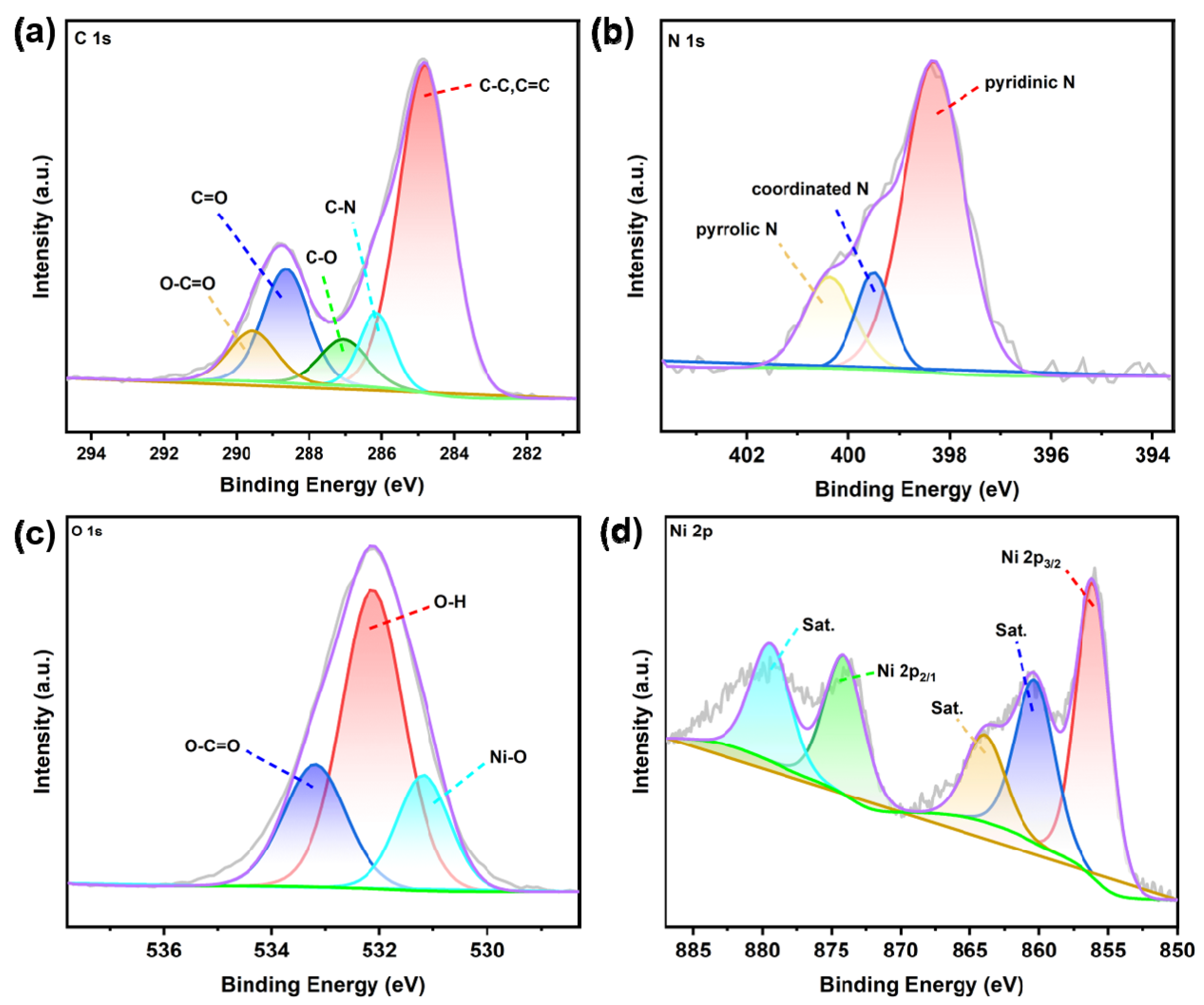
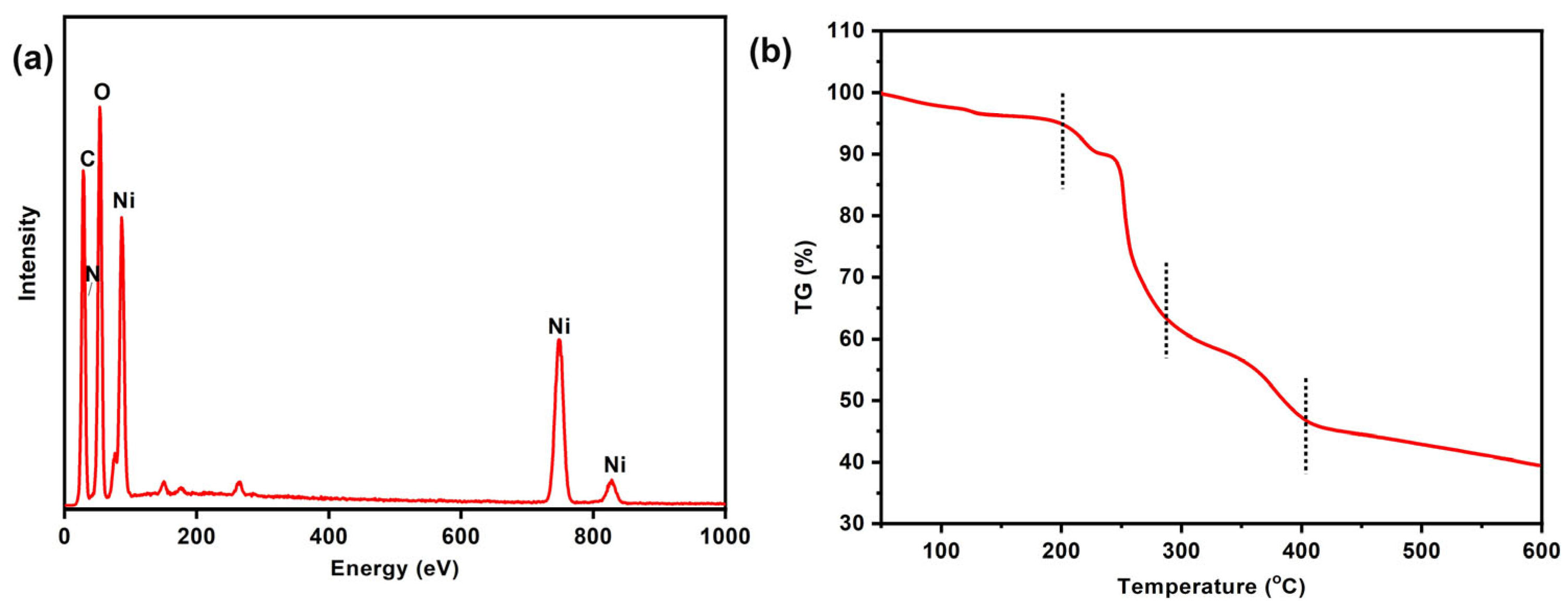


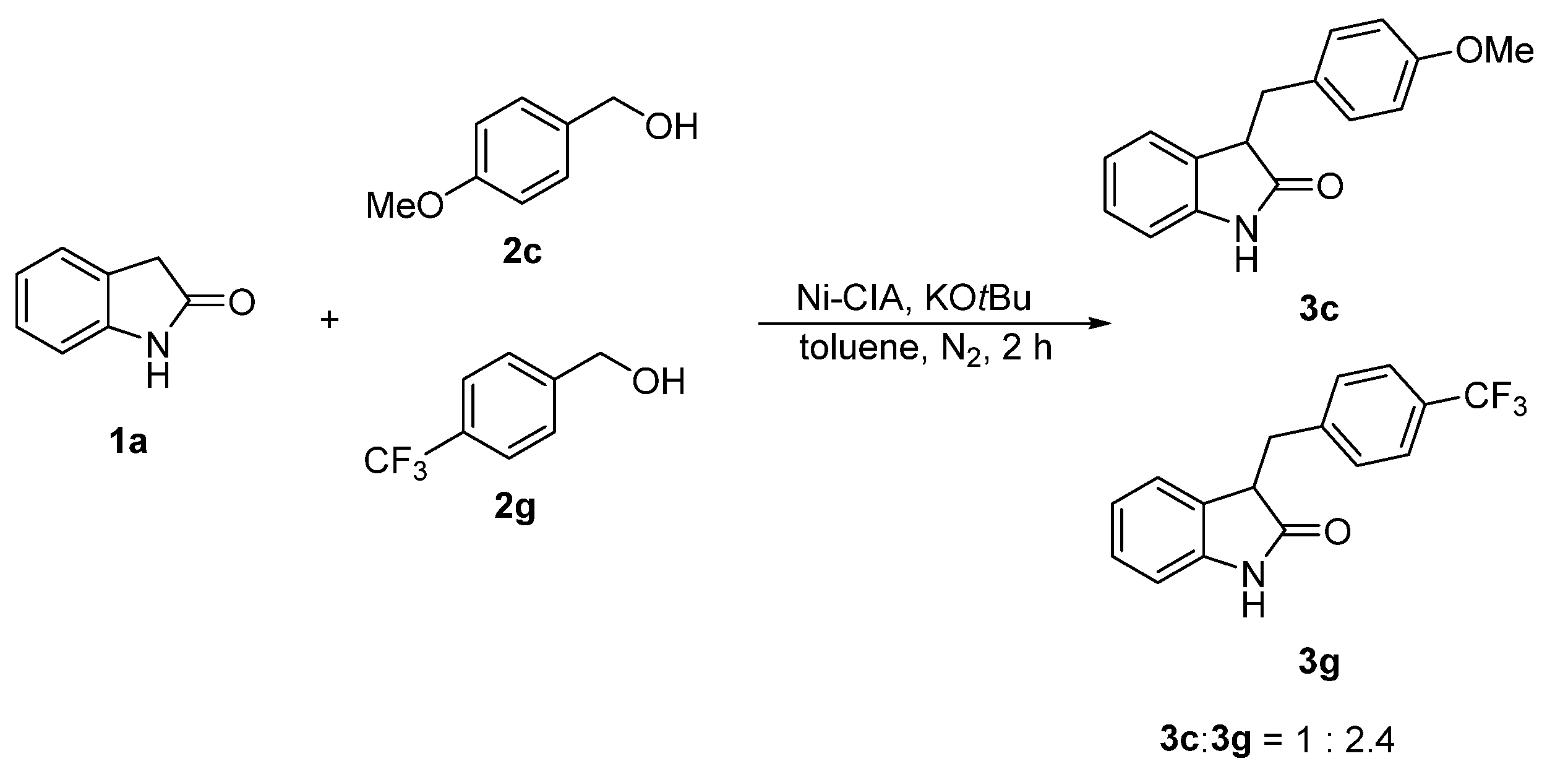

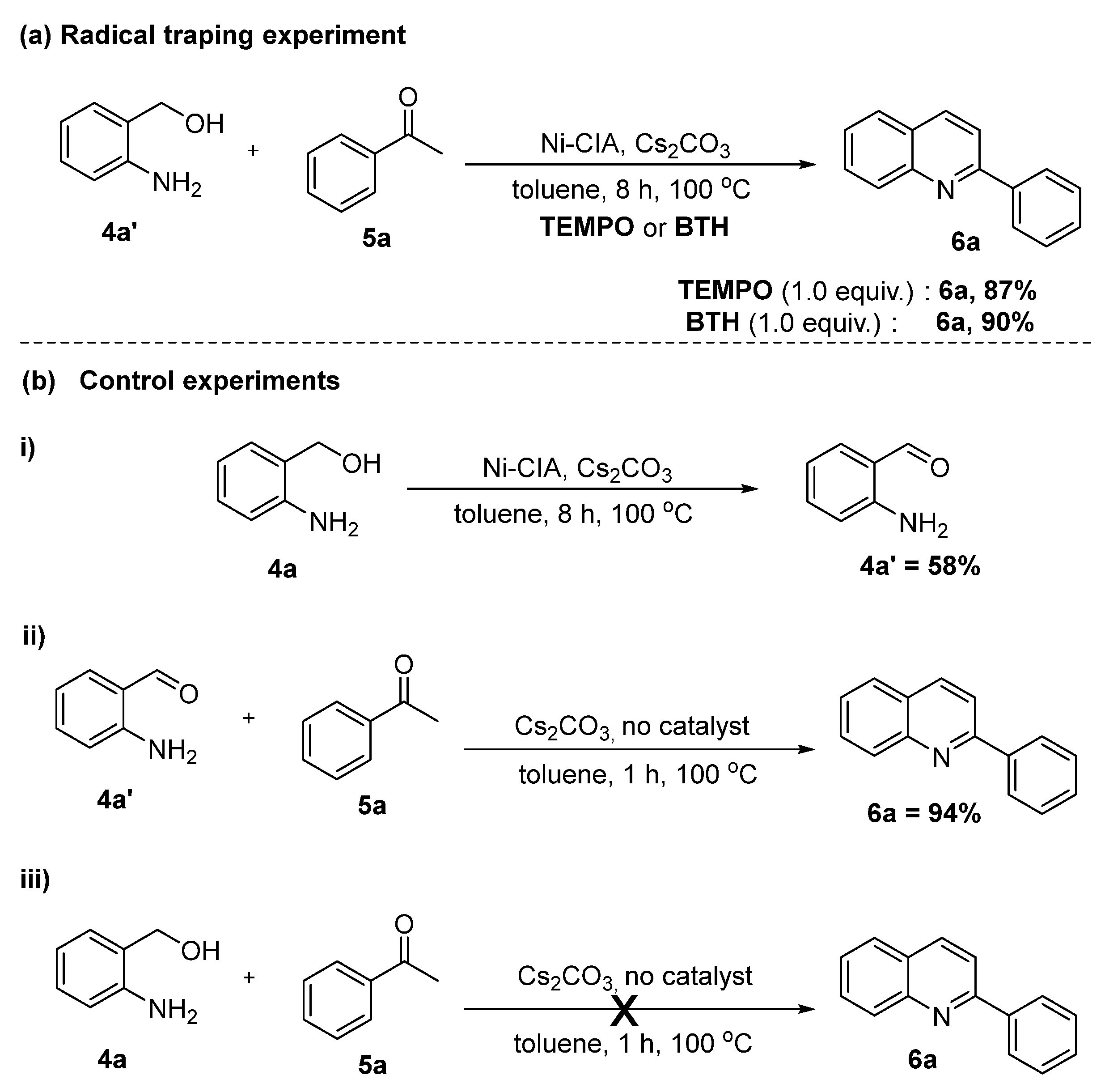

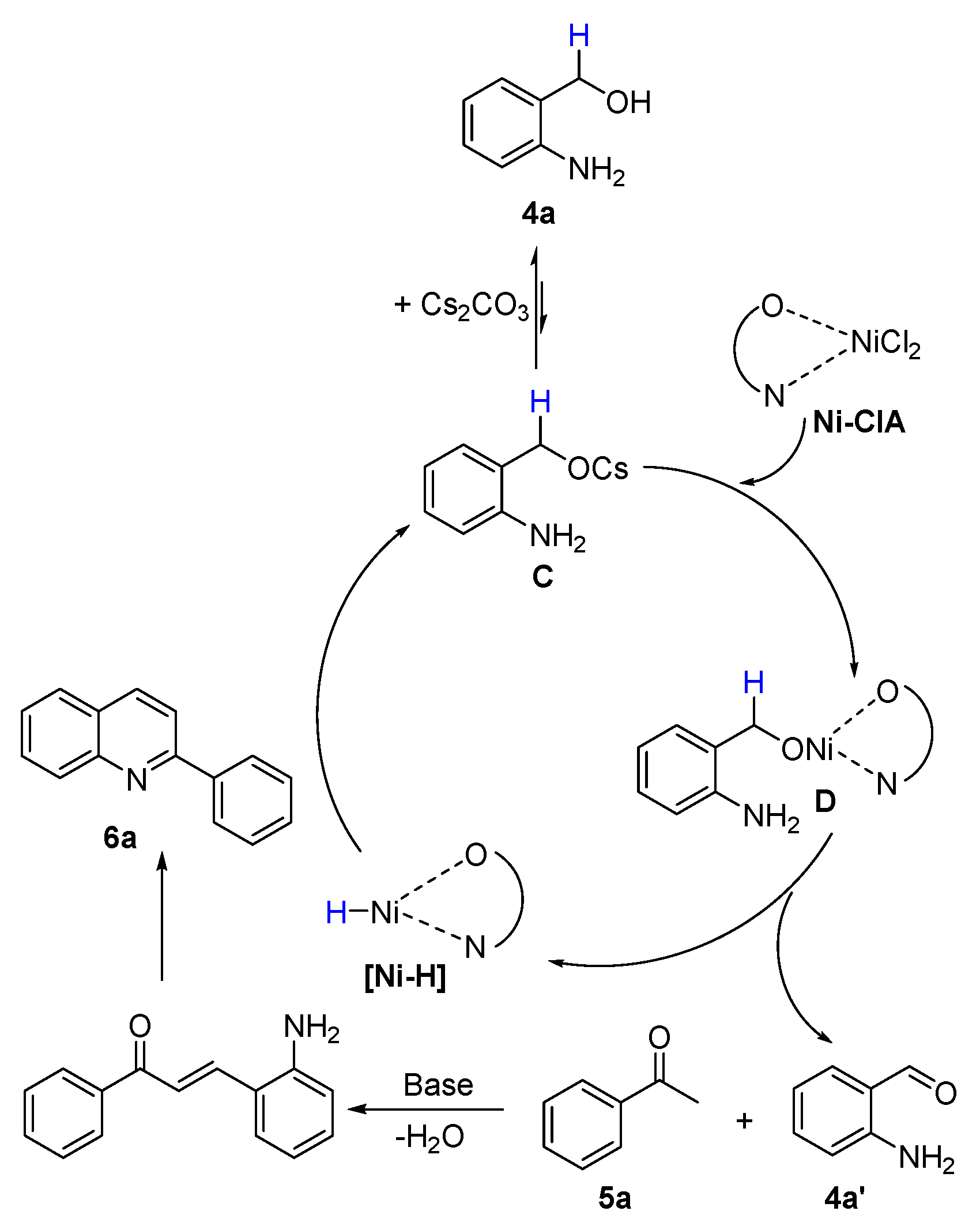


 | |||||
|---|---|---|---|---|---|
| Entry | Catalyst | Base | Time [h] | Solvent | Yield [%] b |
| 1 | - | KOtBu | 6 | toluene | <5 |
| 2 | Ni-CIA | NEt3 | 6 | toluene | 17 |
| 3 | Ni-CIA | K2CO3 | 6 | toluene | 34 |
| 4 | Ni-CIA | Cs2CO3 | 6 | toluene | 65 |
| 5 | Ni-CIA | KOtBu | 6 | toluene | 84 |
| 6 | Ni-CIA | KOH | 6 | toluene | 72 |
| 7 | Ni-CIA | K3PO4 | 6 | toluene | 56 |
| 8 | Ni-CIA | KOtBu | 6 | H2O | <5 |
| 9 | Ni-CIA | KOtBu | 6 | 1,4-dioxane | 76 |
| 10 | Ni-CIA | KOtBu | 6 | xylene | 80 |
| 11 | Ni-CIA | KOtBu | 8 | DMF | 12 |
| 12 | Ni-CIA | KOtBu | 2 | toluene | 63 |
| 13 | Ni-CIA | KOtBu | 6 | toluene | 82 |
| 14 c | Ni-CIA | KOtBu | 6 | toluene | 88 |
| 15 d | Ni-CIA | KOtBu | 6 | toluene | 43 |
 | |||||
|---|---|---|---|---|---|
| Entry | Catalyst | Yield [%] b | Entry | Catalyst | Yield [%] b |
| 1 | NiCl2 · 6H2O | 15 | 5 | NiCl2(bipy)2 | 32 |
| 2 | NiBr2 · 3H2O | <5 | 6 | NiCl2(phen)2 | 45 |
| 3 | Ni(NO3)2 · 6H2O | <5 | 7 | Ni-CIA | 88 |
| 4 | Ni(OAc)2 · 6H2O | <5 | 8 | none | <5 |
Disclaimer/Publisher’s Note: The statements, opinions and data contained in all publications are solely those of the individual author(s) and contributor(s) and not of MDPI and/or the editor(s). MDPI and/or the editor(s) disclaim responsibility for any injury to people or property resulting from any ideas, methods, instructions or products referred to in the content. |
© 2023 by the authors. Licensee MDPI, Basel, Switzerland. This article is an open access article distributed under the terms and conditions of the Creative Commons Attribution (CC BY) license (https://creativecommons.org/licenses/by/4.0/).
Share and Cite
Li, J.; Tang, J.; Wang, L.; Wang, D.; Duan, Z.-C. Recyclable Ni-Containing Coordination Polymer as an Efficient Catalyst for the Synthesis of Oxindole and Quinoline Derivatives through the Borrowing Hydrogen Strategy. Catalysts 2023, 13, 1195. https://doi.org/10.3390/catal13081195
Li J, Tang J, Wang L, Wang D, Duan Z-C. Recyclable Ni-Containing Coordination Polymer as an Efficient Catalyst for the Synthesis of Oxindole and Quinoline Derivatives through the Borrowing Hydrogen Strategy. Catalysts. 2023; 13(8):1195. https://doi.org/10.3390/catal13081195
Chicago/Turabian StyleLi, Jiahao, Jiajie Tang, Likui Wang, Dawei Wang, and Zheng-Chao Duan. 2023. "Recyclable Ni-Containing Coordination Polymer as an Efficient Catalyst for the Synthesis of Oxindole and Quinoline Derivatives through the Borrowing Hydrogen Strategy" Catalysts 13, no. 8: 1195. https://doi.org/10.3390/catal13081195




